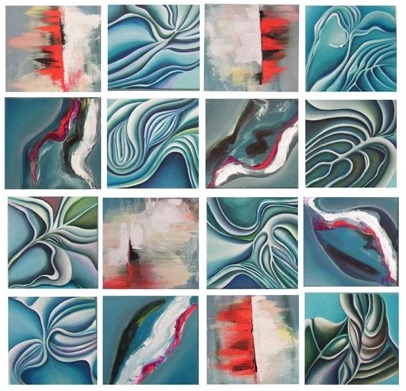Foi, espoir et amour : postscript sur les processus interprofessionnels de génération novatrice nterprofessionnels de génération novatrice
Contenu principal de l'article
Résumé
Universités Canada, le Conseil des arts du Canada et plusieurs sources prônent le développement de la créativité et de la capacité d’innovation par le biais de vastes approches interdisciplinaires, de la collaboration, de partenariats et de réseautage. Mais la mécanique relationnelle de la collaboration au sein d’équipes interdisciplinaires et de partenariats combinatoires demeure équivoque. S’inspirant de pratiques d’éducation interprofessionnelle dans le domaine de la santé, les auteurs proposent trois principes fondamentaux et un examen réflexif du travail en équipe. Ils présentent huit poèmes ekphrasiques écrits en collaboration en vue d’une exposition internationale itinérante de graveurs et proposent ce procédé d’écriture de poèmes comme stratégie d’apprentissage générative. Ils utilisent ce processus pour expliquer la façon d’accéder à une véritable collaboration.
Mots-clés : recherche interdisciplinaire, questionnement poétique, ekphrasis, recherche concertée, éducation interprofessionnelle, examen réflexif.
Téléchargements
Renseignements sur l'article

Cette œuvre est protégée sous licence Creative Commons Attribution - Partage dans les Mêmes Conditions 4.0 International.
The copyright notice is CC BY SA.
This license lets others remix, tweak, and build upon your work even for commercial purposes, as long as they credit you and license their new creations under the identical terms. All new works based on yours will carry the same license. Thus any derivatives will also allow commercial use. For example, if someone translates your article into French, the French version of the article will also have to be shared under a CC BY SA license.
Références
Bridges, D. R., Davidson, R. A., Odegard, P. S., Maki, I. V., & Tomkowiak, J. (2011).
Interprofessional collaboration: Three best practice models of interprofessional education.
Medical Education Online, 16. doi.org/10.3402/meo.v16i0.6035
Canada Council for the Arts. (2018). Digital Strategy Fund. Retrieved from http://canadacouncil.ca/funding/strategic-funds/digital-strategy-fund.
Csikszentmihalyi, M. (1996). Creativity: Flow and the psychology of discovery and invention. New York, NY: HarperCollins.
Daignault, J. (1992a). Traces of work from different places. In W. Pinar & W. Reynolds (Eds.),Understanding curriculum as phenomenological and deconstructed text (pp. 195-215). New York, NY: Teachers College Press.
Grumet, M. (1978). Songs and situations. In G. Willis (Ed.), Qualitative evaluation (pp. 274-315). Berkeley, CA: McCutchan.
Hu, T-H. (2016). A prehistory of the cloud. Cambridge, MA: MIT Press.
Institute of Medicine. (2015). Measuring the impact of interprofessional education on collaborative practice and patient outcomes. Washington, DC: National Academies Press.
Kaufman, J. C., & Sternberg, R. J. (2006). The international handbook of creativity. New York, NY: Cambridge University Press.
Online etymology dictionary (2018). Curate. Retrieved from http://www.etymonline.com/index.php?term=curate.
Padgaonkar, N. (1997, March 17). An interview with Jacques Derrida. Retrieved from http://mural.uv.es/mibosa/DerridaInterview2.htm
Sameshima & Wiebe Canadian Review of Art Education, 45(1), 152.
Pinar, W. F. (1975). The method of “currere.” Paper presented at the Annual Meeting of the American Research Association. Washington, DC. Retrieved from https://files.eric.ed.gov/fulltext/ED104766.pdf
Pink, D. H. (2005). A whole new mind. New York, NY: Penguin Group.
Remen, R. (2000). My grandfather’s blessings. New York, NY: Riverhead Books.
Robinson, K. (2018). Sir Ken Robinson.com. Retrieved from http://sirkenrobinson.com/
Sameshima, P. (2008). Letters to a new teacher: A curriculum of embodied aesthetic awareness. Teacher Education Quarterly, 35(2), 29-44.
Sameshima, P., & Irwin, R. (2008). Rendering dimensions of a liminal currere. Transnational Curriculum Inquiry, 5(2), 1-15.
Sameshima, P., Wiebe, S., & Hayes, M. (in press). Imagination: The generation of possibility. In B. W. Andrews (Ed.), Perspectives on arts education research in Canada, Vol 1: Surveying the landscape, Rotterdam, The Netherlands: Sense.
Smith, N. (2012, May 7). Who says creativity can’t be learned. Business News Daily. Retrieved from http://www.businessnewsdaily.com/2471-creativityinnovation-learned.html.
Thompson, D. S. (2016). Complexity theory and interprofessional education in health.
Electronic Theses and Dissertations. 5918. Retrieved from https://scholar.uwindsor.ca/etd/5918.
Turak, A. (2011, May 22). Can creativity be taught? Forbes. Retrieved on September 19, 2012,
from http://www.forbes.com/sites/augustturak/2011/05/22/can-creativity-be-taught/.UCL
Material culture (2013). University College London, Anthropology, Material Culture. Retrieved from http://www.ucl.ac.uk/anthropology/material-cul
Universities Canada (2016, November). Mobilizing people and ideas: Supporting the creative economy and fostering Canadian culture in the digital world. Retrieved from
Vreeland, N. (2011). Foreword. H. H. the Dalai Lama, A profound mind: Cultivating wisdom in everyday life (vii-xi). New York, NY: Three Rivers Press.
Wiebe, S. (2016). An experiment in poetic-psychoanalytic therapy: What is good for the poem is good for the poet. In K. Galvin, L. Todres, & M. Prendergast (Eds.), Poetic inquiry: Seeing, understanding, and caring (pp. 181-191). Rotterdam, The Netherlands: Sense.
Wiebe, S., & Sameshima, P. (2018, February). Sympathizing with social justice, poetry of invitation and generation. Art/Research International, 3(1)7-29. doi:http://dx.doi.org/10.18432/ari29243

